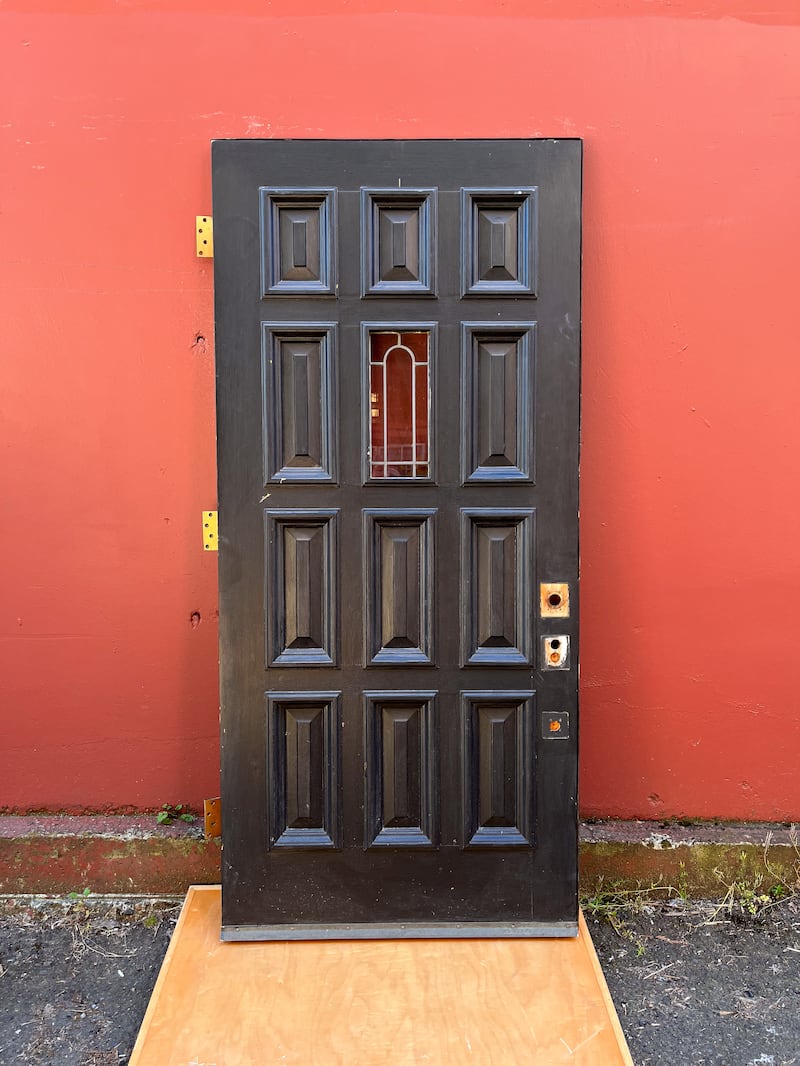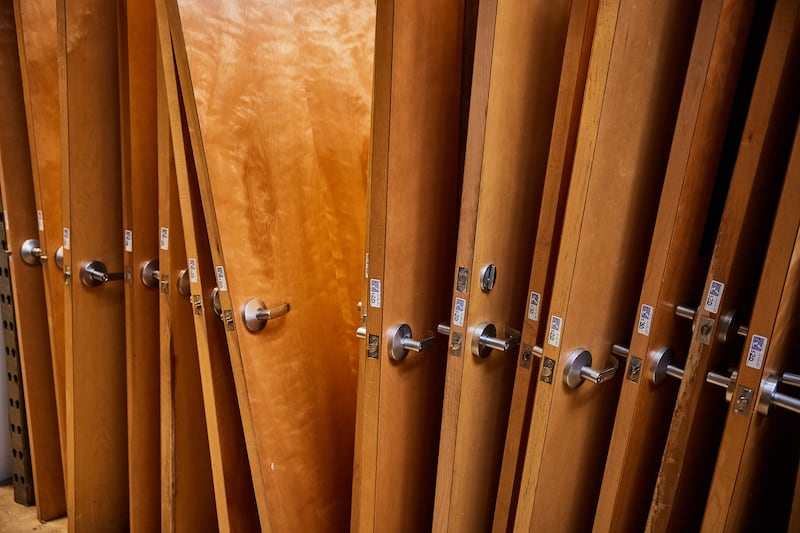Stepping through the doors of the ReBuilding Center is like walking into a dragon’s hoard of treasures.
The giant warehouse on North Mississippi Avenue is packed to the rafters with items saved from the sledgehammer’s savagery. Boards, beams, and joists, scarred and tanned by the years, stand proud and strong. Doors in all shapes and sizes beckon like portals to an unknown dimension. Lighting fixtures, from upturned teacups to paper lanterns, dazzle the eye. Doorknobs by the dozen are displayed like doughnuts in a bakery, set out in flavors of brass, bronze, glass, and copper. Cabinets, sinks, bathtubs, and enough toilets to seat a battalion of buttocks.

But this trove of salvaged wonders didn’t build itself. These items were rescued from the scrapheap through a process known as “gentle demolition” or deconstruction.
The basic idea is simple: instead of demolishing an old house or a room and throwing the resulting debris into the landfill, contractors deconstruct it—take it apart—and salvage valuable materials so they can be reused.
Salvage, also known as reconstruction—rebuilding through reclaimed, recycled or upcycled materials —is a perfect match for a city of do-it-yourselfers, thrifters, bargain hunters, and individualists. In fact, deconstruction (the process of pulling materials apart before the rebuild) has such a big upside that the city of Portland now requires that all houses built before 1940 must be deconstructed, rather than simply demolished. (Don’t try this yourself—the law states that you have to hire a certified contractor who knows how to deal with hazards like asbestos, lead paint, and so on.)

Maybe you can’t stand the putty-pink hue of that bathroom sink, but it could be used and loved by another family. Same goes for the groovy ‘70s-era cabinets in your kitchen: they may not fit your midcentury modern aesthetic, but they’d be a godsend to your neighbors down the street.
This cycle of deconstruction and reuse has three main advantages, says Jackie Kirouac-Fram, executive director of the ReBuilding Center. First, it benefits the environment. Second, recycled materials are more affordable than new ones. Third, it promotes self-sufficiency and supports the local economy. Salvaged items are so useful that the ReBuilding Center will pick them up from your house for free.
So, how do these advantages actually work with deconstruction?
First, regarding sustainability, salvaged materials reduce the demand for new materials, which means less resource extraction, less pollution, less global warming, and less waste. “Recycling is a vital part of the construction process,” says Daniel Thomas of local construction and remodeling firm Hammer & Hand. “We can’t just throw things away.”
Then, there’s the affordability factor. A basic brand-new toilet will set you back hundreds of dollars at a big-box store, but you can pick up a reclaimed one for 30 bucks. The quality of reclaimed materials is often very high, because of the handmade craftsmanship in old items like locks and hinges. Reclaimed materials are particularly important for low-income or first-time homeowners, who might not otherwise be able to maintain or repair their homes.
Salvaged materials also have character and may require a touch of skill or ingenuity to shine in their new location. That’s where self-sufficiency and craftsmanship come in. Sizing up a sink is a great way to learn about the rudiments of plumbing and gain knowledge that comes in handy later on, when you need to fix a leaky toilet. “Inability to do repairs is a key reason why people don’t keep or maintain their homes,” Kirouac-Fram says.
Once you buy into the idea that funky old stuff can—and should—enjoy a second life, that’s when the fun begins.
Kama Dersham is constantly inspired by the creative solutions she sees in her work as a real estate broker who specializes in older homes. “A home is built out of wood, brick, and metal,” she says. “But it’s also built out of memories.”
Dersham has seen an old piano with a cracked frame get new life as a bar or sideboard. Finding new purpose for old objects is an opportunity to cherish memories and add character, like an old refrigerator door repurposed for a pantry, or a battered tuba finding new life as a hanging lamp.
But creative reuse isn’t just about objects, she says. It’s also about spaces. “It’s looking at a tiny closet and seeing a half-bath, or turning an attic into a fort for the kids,” she says.
It’s not all positives though—some reclaimed items are problematic, says Thomas of Hammer & Hand. Old single-pane windows, for example, have terrible insulation values and are notorious for wasting energy. “From a carbon standpoint, it makes more sense to put energy-efficient windows in a leaky old house, and use your vintage windows for greenhouses or art projects,” he says. “The carbon cost to heat and cool an inefficient space over its lifetime can significantly outstrip the embodied energy in its materials.”
Reclaimed framing lumber (that’s the wood in your house that’s hidden behind walls and other stuff) was often milled from old-growth timber, and is much stronger and more durable than new wood. However, those old boards often come in unusual dimensions, or have warps or cracks that make them difficult to reuse for their original purpose. It’s often easier to reuse them for other things. Thomas loves to see old lumber transformed into wall paneling, trim, flooring, and furniture.
“The old framing here in Portland is mainly Douglas fir or hemlock,” he says, “and was likely old growth with beautiful tight grain, full of character—dents and scars, and the deep rich color from long oxidation.”

What if this all sounds great, but the only screwdriver you know how to hold comes with a wedge of orange? Don’t let that hold you back. Portland Community College, the ReBuilding Center, and other community nonprofits offer classes on woodworking, plumbing, electricity, and other crafts. Instead of squeaking helplessly when a hinge comes loose, grab a drill and set things straight.
As they say, what goes around, comes around.
Resources for Reclaimers:
The ReBuilding Center
3625 N Mississippi Ave., 503-331-9291, rebuildingcenter.org.
Hippo Hardware and Trading Co.
1040 E Burnside St., 503-231-1444, hippohardware.com.
Habitat for Humanity ReStore
12413 NE Marx St., 503-287-9529, pdxrestore.org.
Lovett Deconstruction and Salvage
4315 NW St. Helens Road, 503-954-2347, lovettdeconstruction.com.
Hammer & Hand
1020 SE Harrison St., 503-232-2447, hammerandhand.com.
KamaHomes
919 NE 19th Ave., #100, 503-336-6868, kamahomes.com.
This story is part of Nester, Willamette Week’s annual home magazine. It is free and can be found all over Portland beginning Monday, Sept. 23, 2024. Find your free copy at one of the locations noted here, before they all get picked up! Or, order one through our store.

